Japan
Wood Products Prices
Dollar Exchange Rates of 15th
July
2025
Japan Yen 147.40
Reports From Japan
Election becoming referendum on consumption
tax cut
The election in Japan is becoming a referendum on
whether the country should cut its consumption tax as
households continue to struggle with a cost-of-living
crisis. A clear dividing line has emerged between the
ruling coalition of the Liberal Democratic Party and
Komeito, which is advocating a one-time cash handout
and opposition parties are calling for varying degrees of
cuts to the consumption tax, a form of value-added tax on
purchases of all goods and services.
Economy back on track
Japan's economy grew at an annualised pace of 0.9% in
May led by private-sector capital expenditure according to
an estimate released by the Japan Center for Economic
Research (JCER). This marked a reversal from the
previous month when a Nikkei-affiliated think tank
estimated that the economy contracted an annualised
0.7%.
Tariff negotiations with US back to the beginning
Japan's hopes of securing a trade deal with the US was
shattered when the US described Japan, a close ally as
"spoiled" and the recent declaration on the US tariff level
for Japan seemed to shatters Japan's hopes for a special
deal on tariffs. In recent negotiations Japan has
emphasised its huge investments in the US and the
strategic alliance.
Japan’s Prime Minister expressed confidence that Japan
would be treated differently as "Japan is the world's largest
investor in the US and creates the largest number of jobs".
Lizzi Lee, a fellow at the Asia Society Policy Institute's
Center for China Analysis, told Nikkei Asia "Japan is
holding on to a set of assumptions about alliances, cost-
benefit calculations and grand strategy that no longer fully
apply. For decades, Japan's strategic posture was built on
the idea that its role as America's most reliable ally in
Asia, along with its massive foreign-direct-investment
footprint in the US and its stance on the China-Taiwan
P.o.C issue would provide an opportunity for special
treatment."
See: https://asia.nikkei.com/Economy/Trade-war/Trump-
tariffs/Trump-s-tariff-letter-shatters-Japan-s-hopes-for-a-special-
relationship
Tariffs could reduce GDP by almost 1%
The 25% reciprocal tariff on imports from Japan, if
imposed, is projected to reduce GDP by at least 0.8% in
2025 according to a private-sector estimate. Over the
longer term through to 2029, the newly set tariff that takes
effect on 1 August is estimated to cut Japan's GDP by
1.9% according to the Daiwa Institute of Research.
Along with other tariffs imposed, including the 27.5%
duty on automobiles, the US trade policy could result in a
marked economic downturn.
See: https://japantoday.com/category/politics/trump's-25-tariff-
to-reduce-japan's-gdp-by-0.8-in-2025-think-tank
Dividends on track for record despite tariff turmoil
The domestic media has reported Japanese companies are
expected to raise their dividends for a fifth record high for
this fiscal year even with trade tensions expected to erode
earnings. This could translate into a boost wages and
consumer spending. Annual dividends for 2,300
companies that closed their books in March 2025
expanded around 3%.
Summer heat returns
The oppressive summer heat in Japan brings broad risks to
the economy, potentially leaving consumers with less
money to spend as work hours shrink and energy costs
rise, as well as less desire to spend.
June Japan's hottest month since in records dating back to
1898 began with temperatures averaging 2 degrees C
above normal according to the Japan Meteorological
Agency.
In parts of Japan, mainly in the west, the rainy season
ended two or three weeks earlier than usual and
temperatures have topped 35 degrees C on some days.
Cost-of-living pressures undermining consumer
sentiment
An Australian government website has commented that
Japan’s economy has long-faced flat or falling prices that
prompted traditionally conservative consumers to save
rather than spend making it difficult to spur economic
growth. Inflation is now increasing; the headline consumer
price index remained above 2% year-over-year for the
third straight month in June. Meanwhile, the yen recently
hit yen147 against the US dollar, its lowest in more than
two decades.
These forces may be more negative than positive for the
world’s third last economy because the rise in consumer
prices is being driven by rising food and energy costs
rather than sustained increases in wages and economic
activity. This is contributing to cost-of-living pressures,
undermining consumer sentiment and eroding household
purchasing power.
See: https://www.exportfinance.gov.au/resources/world-risk-
developments/2022/august/japan-weaker-yen-and-higher-
inflation-hit-consumers-and-businesses/
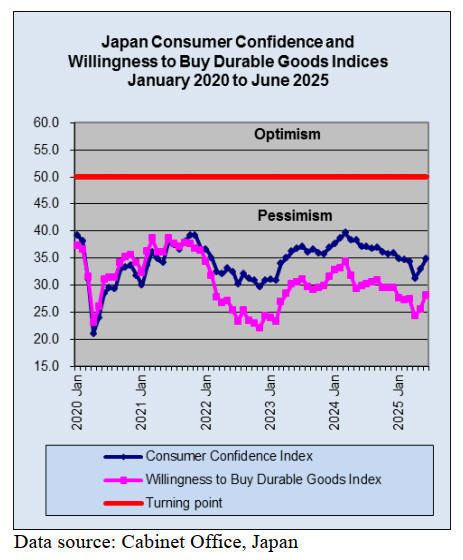
Yen dropped to 147 to the US dollar
The US dollar briefly rose to the lower 147 yen range in
early July as US long-term interest rates climbed amid
waning expectations for a Federal Reserve rate cut
because of higher US inflation from tariffs seen as a key
factor.
Currency analysts have suggested the 25% tariff on
Japanese goods may undermine the Bank of Japan plans to
normalise interest rates which could extend the yen
weakness against the dollar.
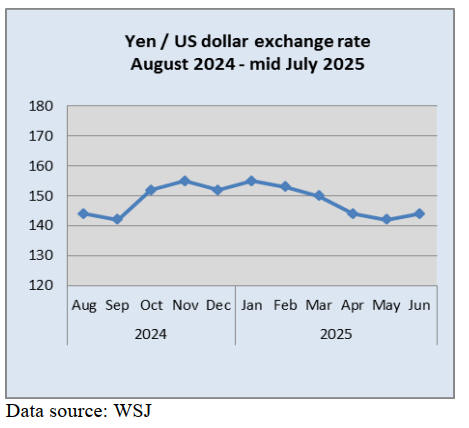
Real Estate Information website a hit
The Ministry of land in Japan has expressed surprise that
its Real Estate Information website attracted more than 10
million hits in a six month period.
The Real Estate Information Library released by the
Ministry can overlay data necessary for property
transactions on a single map and has been proving
popular. It allows users to see information on real estate
transaction prices, school districts, hazard maps and more,
in addition to the standard land prices. It also offers an
English language option.
See:
https://mainichi.jp/english/articles/20241015/p2a/00m/0na/00500
0c
and
https://www.reinfolib.mlit.go.jp/
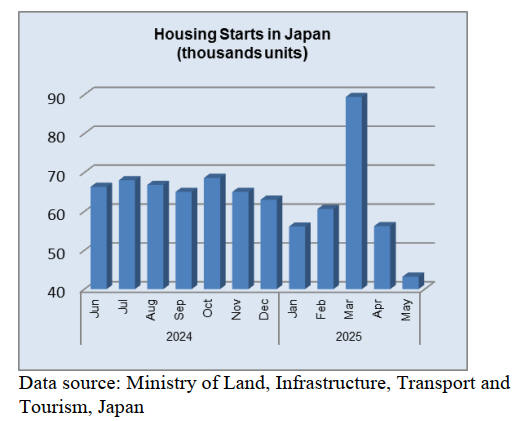
Import update
Assembled wooden flooring imports
The main category of assembled flooring imports in May
2025 was HS441875, accounting for 58% (75% in April)
of the total value of assembled flooring imports compared.
Of HS441875 imports, 67% was provided by shippers in
China, 16% by shippers in Viet Nam and 13% by shippers
in Malaysia. The other main source of assembled flooring
(HS441875) in May was Thailand.
The second largest category in terms of value in May
2025
was HS441873 (21% of the total in May) all of which was
shipped from China. The third and fourth largest
categories in value terms were HS441879 (10%) and
HS441874 (11%).
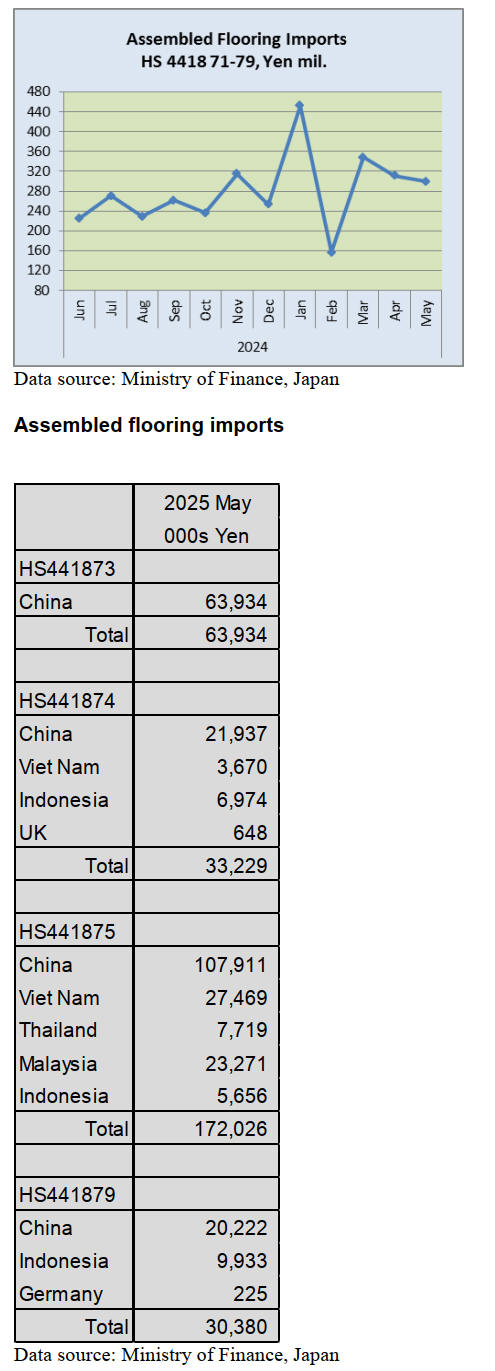
Plywood imports
Activity in the building and construction collapsed in May
mainly as the result of the long ‘golden week’ holiday and
this resulted in very slow domestic sales of plywood. In
May 2025 arrivals of HS441210-39 were down 4% month
on month but were sharply up (36%) compared to May
2024.
Malaysia and Indonesia were the top suppliers in May as
in previous months. The volume of May imports from
Malaysia was slightly down compared to April as were
arrivals from Indonesia and Vietnam. Arrivals from China
in May were at around the same level as in April.
As in previous months, of the various categories of
plywood imported in May 2025, HS441231 was the
largest (87% of total imports) followed by HS441233
(6%) and HS441234 (5%). The balance was of HS441239.
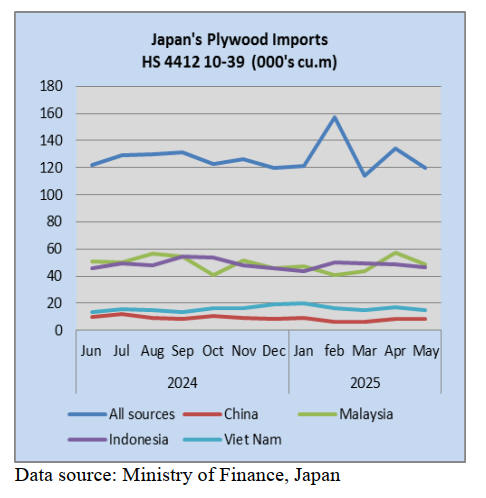
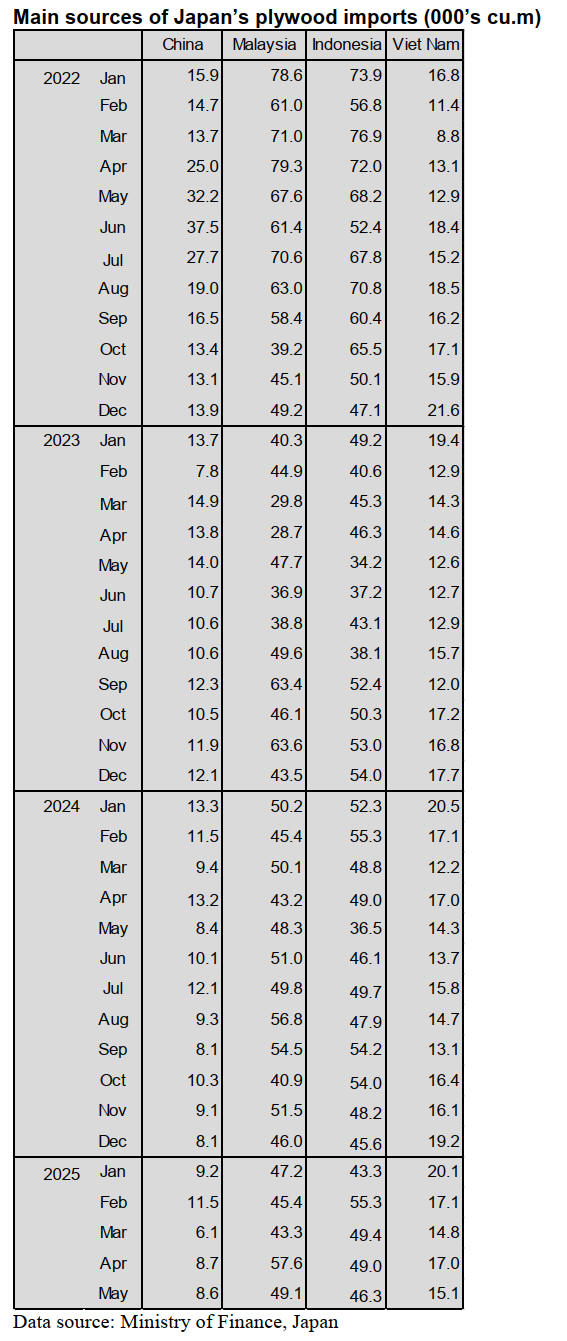
Trade news from the Japan Lumber Reports (JLR)
The Japan Lumber Reports (JLR), a subscription trade
journal published every two weeks in English, is
generously allowing the ITTO Tropical Timber Market
Report to reproduce news on the Japanese market
precisely as it appears in the JLR.
For the JLR report please see:
https://jfpj.jp/japan_lumber_reports/
US to expand supplying lumber
On May 30, 2025, the U.S. Forest Service announced its
goal to increase the annual supply of lumber by at least 25
% over the next four to five years. It also aims to supply 4
billion BF (approximately 9.44 million cbms) of lumber
annually by fiscal year 2028.
The strategy is said to align with Executive Order 14225,
issued by President Trump in March 2025, which calls for
the immediate expansion of American timber production.
On May 29, the U.S. Secretary of Agriculture announced a
$200 million investment to implement the strategy, aiming
to expand timber production, strengthen rural economies,
and stabilize American industry.
Expansion of locally sourced and domestic hardwood
utilisation in Japan
Niigata Gouhan Shinko Co., Ltd. in Niigata Prefecture has
announced plans to install veneer drying and strength
grading equipment by mid-October, 2025, with the goal of
restoring its monthly plywood production volume to 4,000
cbms.
The total investment for this series of equipment upgrades
is expected to reach 2 billion yen.
In January 2024, the company experienced a fire involving
a softwood veneer dryer at its third plant. With support
from repairs, restoration efforts, and veneer supply
assistance from peer companies, the company resumed
plywood production in August 2024 at a monthly volume
of 2,500 cubic meters representing a 28.6% to 37.5%
decrease compared to pre-fire levels.
The company currently uses 37,100 cbms of domestic
timber annually, of which 29,600 cbms are sourced from
Niigata Prefecture. Starting from the fiscal year ending
March 2027, it aims to expand this volume to 55,000 cbms
by the fifth year (fiscal year ending March 2031)
representing a 1.9-fold increase.
North American logs
Demand for lumber products within Japan is balanced,
albeit at a low level. While there has been some demand
due to a shortage of Douglas fir lumber in the market,
there hasn't been a significant surge, as the slump in
detached housing construction and the rise in single-story
homes have kept growth in check.
Construction starts at building sites in May and June, 2025
lost momentum as they were delayed due to setbacks in
approval-related procedures stemming from regulatory
changes implemented in April,
2025.
As a result the movement of goods and operating levels at
precutting plants varied significantly, with some
experiencing a rush in activity ahead of the changes and
others facing a lull afterward. However, there is strong
sentiment that the situation will recover to levels
comparable to the previous year by summer.
The price of KD Douglas fir beam is 68,000 – 71,000 yen,
delivered per cbm. KD Doulgas fir square costs around
80,000 yen, delivered per cbm. KD Douglas fir small
lumber is around 85,000 yen
South Sea logs and lumber
The movement of hardwood products has shown
fluctuations due to exchange rate changes, but overall, it
remains lackluster as end-user demand continues to be
weak. In early May, when the yen shifted from
appreciation to depreciation, some buyers moved to secure
supplies early in anticipation of further weakening.
However, as the yen began to strengthen again, that wave
of demand subsided.
In producing regions the impact of China’s suspension of
U.S. hardwood log imports continues to be felt. In
Indonesia as well, furniture manufacturers targeting the
U.S. market have seen a slowdown in orders. Producers of
laminated free boards are also experiencing a decline in
business, reflecting the indirect impact of U.S. tariff
policies.
However, in the producing regions, there are concerns that
the decline in demand for logs bound for China could lead
selected for Japan. With remaining uncertain, it is also
difficult to predict trends in the supply regions of imported
hardwood.
|